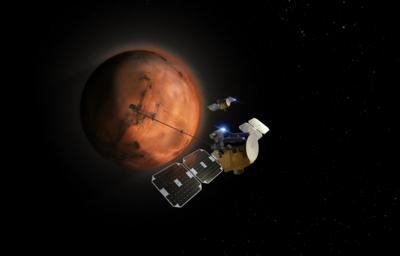Wed, Jun 16, 2021
Two Photons (Named Blue And Gold) Will Insert Themselves Into Elliptical Orbits Around Mars
Rocket Lab has been awarded a contract to design two Photon spacecraft for a scientific mission to Mars.

The Escape and Plasma Acceleration and Dynamics Explorers (ESCAPADE) mission, led by Rob Lillis at the University of California, Berkeley Space Sciences Laboratory, is a twin-spacecraft science mission that will orbit two spacecraft around Mars to understand the structure, composition, variability, and dynamics of Mars' unique hybrid magnetosphere. The mission will leverage its unique dual viewpoint on the Mars environment to explore how the solar wind strips atmosphere away from Mars to better understand how its climate has changed over time.
ESCAPADE is being developed under NASA’s Small Innovative Missions for Planetary Exploration (SIMPLEx) program in the Science Mission Directorate (SMD). The two spacecraft are planned for launch in 2024 to Mars ridesharing aboard a NASA-provided commercial launch vehicle.
Following an 11-month interplanetary cruise, the two Photons (named Blue and Gold) will insert themselves into elliptical orbits around Mars and conduct a 1-year primary science mission. ESCAPADE’s Photons will use the flight-proven Curie propulsion system to perform Mars orbit insertion and will be equipped with other subsystems that enable planetary science, including star trackers and reaction wheels for precision pointing from Rocket Lab’s Sinclair Interplanetary team, as well as ranging transceivers for deep space navigation.
Rocket Lab founder and CEO, Peter Beck, says: “This is a hugely promising mission that will deliver big science in a small package. Planetary science missions have traditionally costed hundreds of millions of dollars and taken up to a decade to come to fruition. Our Photon spacecraft for ESCAPADE will demonstrate a more cost-effective approach to planetary exploration that will increase the science community’s access to our solar system for the better.”
ESCAPADE is one of three missions selected in 2019 by NASA’s SIMPLEx program to conduct compelling planetary science and provide more opportunities for flight experience to the science community. ESCAPADE will undergo a NASA preliminary design review in June and a confirmation review in July determining whether the mission proceeds to implementation and flight.
More News
Permanent Echo Radar signals reflected from fixed objects on the earth's surface; e.g., buildings, towers, terrain. Permanent echoes are distinguished from “ground clutter&rd>[...]
How To Get A Story On Aero-TV News/Feature Programming How do I submit a story idea or lead to Aero-TV? If you would like to submit a story idea or lead, please contact Jim Campbel>[...]
“The 737 MAX will diversify AviLease’s portfolio by delivering unrivalled fuel efficiency and market-leading versatility. It’s a powerful combination that will fu>[...]
From 2017 (YouTube Edition): The Airplane From Down Under Is A Proven Trainer… Jabiru was one of the early light sport aircraft (LSA) brought into the U.S.A. when the sport >[...]
Also: MQ-9B UAS MTC, FlightSimExpo, New JPL Director, Japanese Lunar Lander Preps Merlin’s flight testing campaign continues to rapidly progress with its certification-ready >[...]
 ANN's Daily Aero-Term (05.17.25): Permanent Echo
ANN's Daily Aero-Term (05.17.25): Permanent Echo ANN FAQ: Contributing To Aero-TV
ANN FAQ: Contributing To Aero-TV Aero-News: Quote of the Day (05.17.25)
Aero-News: Quote of the Day (05.17.25) Classic Aero-TV: Jabiru's New J170-D - An Upgraded and Fine-tuned LSA
Classic Aero-TV: Jabiru's New J170-D - An Upgraded and Fine-tuned LSA Airborne-NextGen 05.13.25: Merlin Tests, Dronetag Accuses, Flying Car?
Airborne-NextGen 05.13.25: Merlin Tests, Dronetag Accuses, Flying Car?



